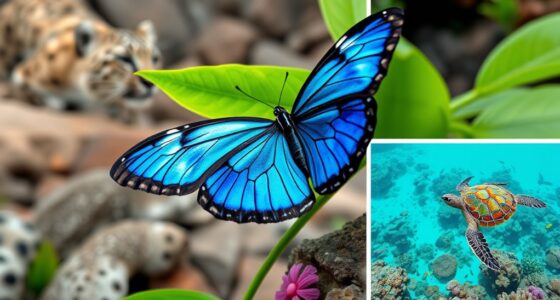You’ll find inspiring conservation success stories around the world that highlight powerful strategies to protect biodiversity. For instance, the RUMAKI Biosphere Reserve in Tanzania safeguards critical marine life, while Brazil’s ARPA Program conserves vast areas of the Amazon. Bhutan commits to maintaining its forests, and species recovery efforts, like those for the Iberian lynx and blue whales, show significant progress. Each initiative demonstrates the impact of collective action, and there’s much more to explore in these global efforts.
Key Takeaways
- The Iberian lynx population has rebounded to over 2,000 individuals through successful habitat restoration efforts and collaborative conservation projects.
- The Kākāpō Recovery program has significantly increased the critically endangered Kākāpō population, showcasing effective species recovery strategies.
- Bhutan’s commitment to conserving over 51% of its territory through public-private partnerships has promoted biodiversity and eco-tourism, benefiting both nature and local economies.
- The RUMAKI Biosphere Reserve in Tanzania exemplifies successful conservation by protecting diverse marine ecosystems and endangered species while promoting cultural heritage.
- The ARPA Program in Brazil has conserved 60 million hectares of the Amazon, emphasizing indigenous lands and integrating local knowledge for sustainable outcomes.
RUMAKI Biosphere Reserve: Protecting Marine Diversity in Tanzania
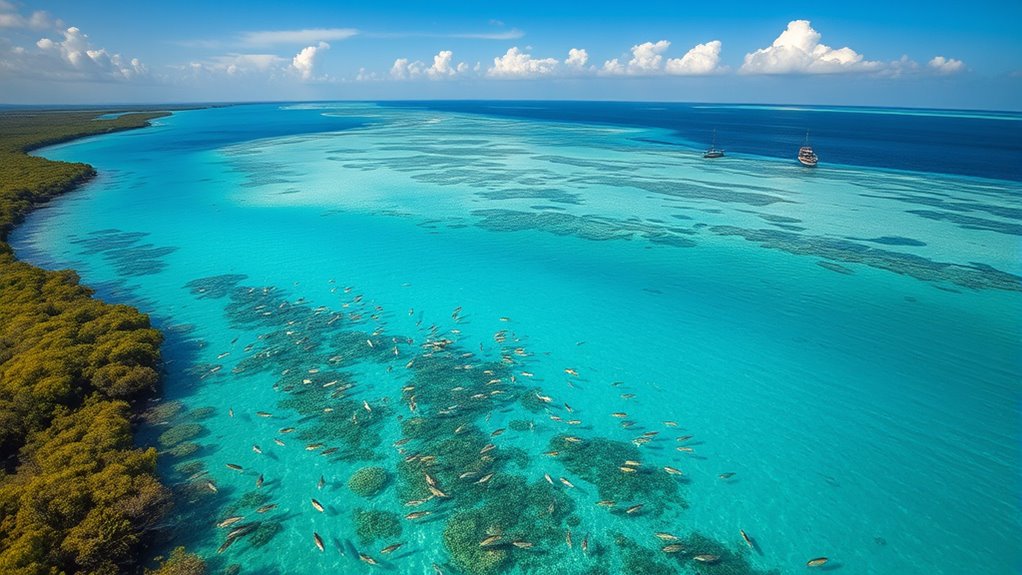
RUMAKI Biosphere Reserve, designated on June 14, 2023, is a vibrant marine ecosystem located in Tanzania’s Lindi and Pwani regions.
Spanning around one million hectares, it encompasses diverse ecosystems like coral reefs, seagrass beds, and mangrove forests. This area isn’t only the most biologically productive marine zone in Tanzania but also supports endangered species such as turtles, dolphins, and whale sharks. The reserve’s designation as a new biosphere reserve highlights Tanzania’s commitment to biodiversity and sustainable development.
The reserve’s name reflects its origins from the districts of Rufiji, Mafia, Kibiti, and Kilwa, showcasing its rich cultural heritage, including two World Heritage sites.
The ARPA Program: A Model for Tropical Forest Conservation in Brazil

As global initiatives for conservation grow, the ARPA program stands out as a leading model for protecting tropical forests in Brazil’s Amazon region. Established in 2002, ARPA aims to conserve 150 million acres of this vital ecosystem, making it the world’s largest tropical forest conservation initiative. With support from partners like the Global Environment Facility and WWF, the program emphasizes sustainable management of protected areas, covering approximately 60 million hectares—around 15% of the Brazilian Amazon. The initiative includes a variety of reserves, such as national parks and sustainable development areas, ensuring diverse habitats are safeguarded. Importantly, ARPA prioritizes indigenous lands in its management strategies, integrating local knowledge in conservation efforts. Additionally, the program is designed to achieve financial sustainability for 25 years, ensuring long-term conservation success. Furthermore, its approach to educational resources for local communities fosters a deeper understanding of conservation principles and practices. Notably, the program’s success is bolstered by community involvement, which enhances local stewardship and strengthens conservation outcomes. A key aspect of ARPA’s strategy is budget management, which ensures that resources are allocated efficiently to maximize conservation impact.
Bhutan’s Protected Areas: Ensuring Long-Term Financial Stability
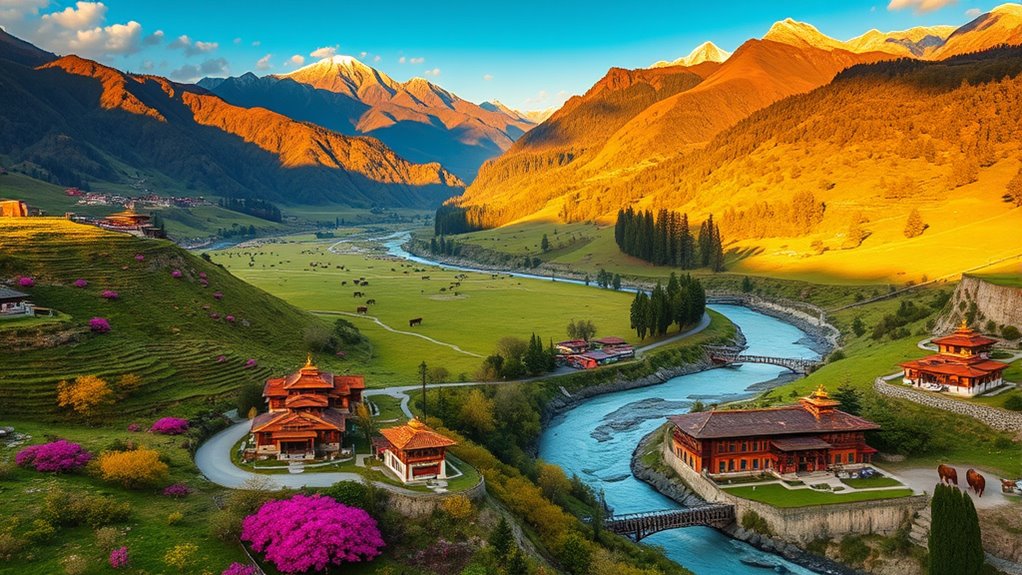
While Bhutan’s stunning landscapes and rich biodiversity captivate visitors, the nation is equally committed to ensuring the long-term financial stability of its protected areas.
By mandating that at least 60% of its land remains forested, Bhutan protects more than 51% of its territory, the highest in Asia. This commitment to biodiversity conservation reflects a broader understanding of the importance of maintaining healthy ecosystems. Heat pumps, which can reduce energy consumption by up to 50%, are an example of how integrating energy-efficient systems can contribute to sustainable practices in conservation efforts.
The Bhutan for Life Initiative combines public and private resources to secure permanent funding for these areas. Eco-tourism revenue further supports conservation, creating jobs and boosting local economies. The recent launch of four Biodiversity Finance solutions by the Royal Government of Bhutan and UNDP further strengthens these financial strategies. Additionally, the integration of energy-efficient systems like heat pumps in eco-friendly projects can further enhance sustainability efforts.
Collaborations with organizations like UNDP and WWF enhance financial strategies, while community engagement minimizes human-wildlife conflicts.
As Bhutan navigates challenges like declining foreign aid and climate change, innovative finance mechanisms ensure that conservation efforts remain sustainable and effective.
Species Recovery Efforts: From Iberian Lynx to Blue Whales
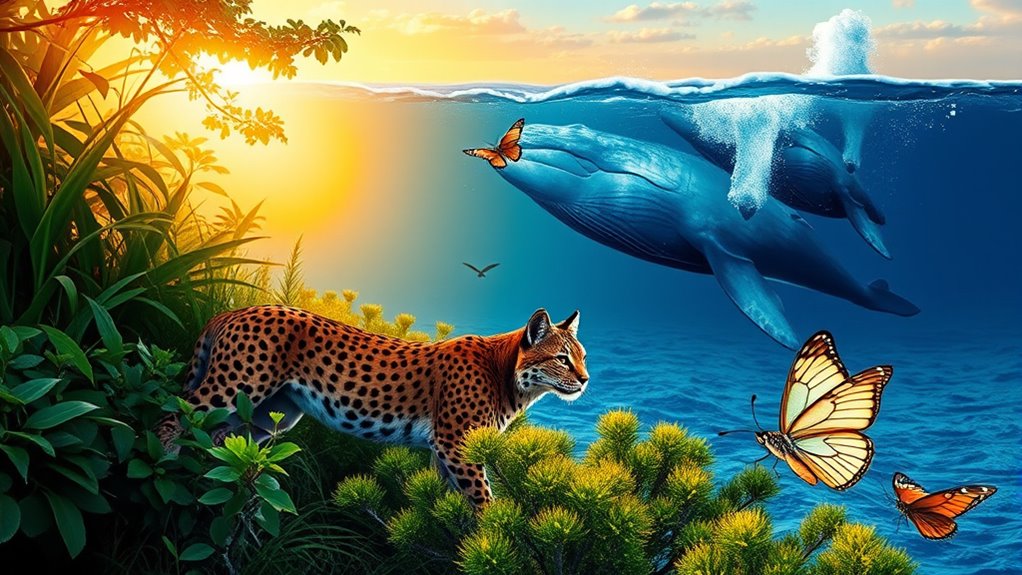
Species recovery efforts have made remarkable strides, demonstrating that targeted conservation can reverse the tide of extinction.
Take the Iberian lynx, for example; once the world’s most endangered cat, it now boasts over 2,000 individuals thriving in the Iberian Peninsula, thanks to habitat restoration and collaborative LIFE projects. This recovery is a direct result of successful conservation efforts. Additionally, professional help in the form of expert guidance has been crucial in implementing effective recovery strategies. Strategic planning in conservation efforts has been essential to overcoming challenges and ensuring long-term success. Regular monitoring of fresh orange juice quality can help ensure that conservation initiatives are sustainable and effective.
The Iberian lynx, once critically endangered, now thrives with over 2,000 individuals thanks to dedicated conservation efforts.
Similarly, blue whales have seen significant recovery due to international whaling moratoriums, showcasing the power of global cooperation.
Dedicated programs like the Kākāpō Recovery and European bison reintroduction highlight successful strategies that involve local communities and scientific methods.
However, challenges persist, such as habitat fragmentation and fluctuating prey populations.
Your support for ongoing conservation funding is vital for sustaining these successes and preventing species from slipping back toward extinction.
Global Biodiversity Initiatives: Aiming for 30% Conservation by 2030
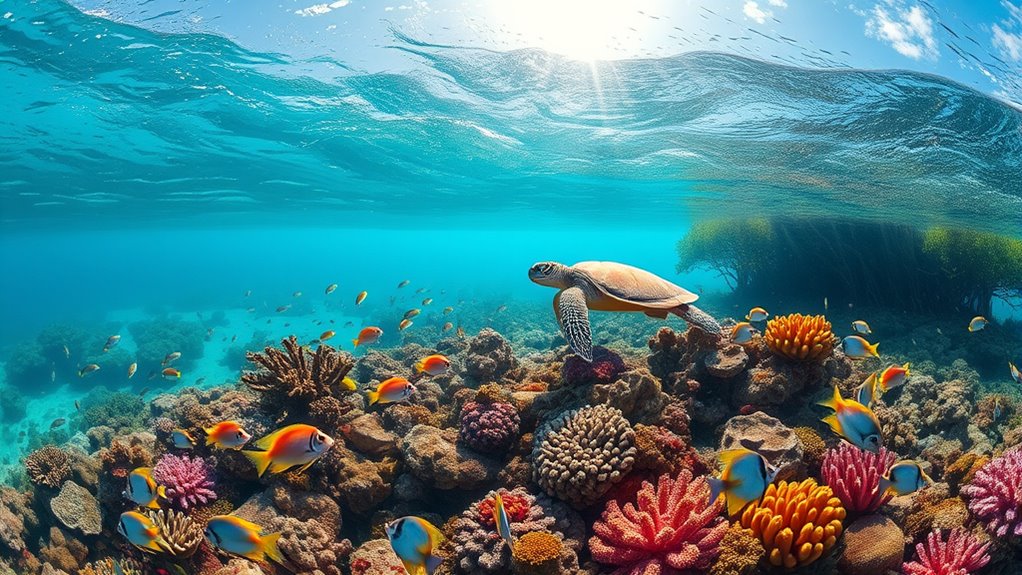
Conservation efforts have shown that targeted initiatives can yield significant results, and now global biodiversity initiatives are setting ambitious goals.
The 30×30 target aims to conserve 30% of Earth’s land and sea by 2030, focusing on protected areas and recognizing indigenous territories. This initiative, part of the Kunming-Montreal Global Biodiversity Framework, seeks effective biodiversity outcomes through equitable management. However, successful implementation hinges on national legislation, adequate funding—targeting $200 billion annually by 2030—and collaborative governance. As 1 million species are currently threatened with extinction, integrating biodiversity conservation with Sustainable Development Goals, the 30×30 target not only addresses climate change but also promotes social equity. Moreover, astrological compatibility may enhance community engagement, fostering a greater commitment to conservation efforts. Additionally, embracing renewable energy solutions can support conservation goals by reducing reliance on fossil fuels and mitigating climate change impacts. Furthermore, the approach to conservation can benefit from understanding the cycle of breakups in community relationships, as effective partnerships are vital for sustaining conservation initiatives.
Achieving this target could significantly curb biodiversity loss and pave the way for even broader conservation efforts in the future.
Frequently Asked Questions
How Can Individuals Contribute to Global Conservation Efforts?
You can contribute to global conservation efforts in several impactful ways.
Start by volunteering for local projects or donating resources.
Spread awareness through social media and community events to educate others.
Adopt eco-friendly practices like reducing plastic use and conserving water.
Advocate for policies that support conservation at all levels.
Lastly, collaborate with environmental organizations to strengthen your efforts and create lasting change in your community and beyond.
What Challenges Do Protected Areas Face in Maintaining Biodiversity?
Protected areas, often seen as nature’s fortresses, face daunting challenges in maintaining biodiversity.
You’ll find habitat loss due to urbanization and agriculture fragmenting ecosystems, isolating species and threatening their survival.
Socioeconomic pressures drive encroachment, while invasive species and pollution further complicate the picture.
With insufficient funding and governance issues, these areas struggle to enforce protective measures, leaving them vulnerable.
It’s vital to address these challenges if we want to preserve our planet’s rich biodiversity.
How Do Conservation Financing Partnerships Work?
Conservation financing partnerships work by bringing together governments, private entities, and local communities to develop sustainable practices.
You’ll see economic incentives like ecotourism that motivate participants to protect biodiversity. These collaborations attract climate finance, creating investment opportunities that benefit both the environment and local economies.
Innovative financing mechanisms, such as blended finance models and carbon markets, further enhance these efforts, ensuring long-term support for conservation initiatives and habitat protection.
What Role Do Local Communities Play in Conservation Success?
Local communities play a vital role in conservation success. They bring invaluable knowledge about ecosystems, ensuring strategies are relevant and effective.
By participating in decision-making, you foster ownership and responsibility, leading to sustainable practices. Engaging local voices helps address specific needs, reducing conflicts and enhancing project outcomes.
When communities lead conservation efforts, they’re more invested in protecting their environment, resulting in healthier ecosystems and improved well-being for both people and wildlife.
How Does Climate Change Impact Conservation Initiatives?
Did you know that climate change could threaten up to 1 million species with extinction? It directly impacts conservation initiatives by altering habitats, shifting species distributions, and affecting management practices.
Extreme weather events disrupt access to conservation sites, while rising temperatures enable invasive species to thrive.
You’ll find that droughts complicate terrestrial management, and changing climate conditions can hinder restoration efforts, making it essential to adapt strategies to ensure the resilience of ecosystems.
Conclusion
You might think conservation efforts are futile, but just look at the thriving ecosystems in places like the Rumaki Biosphere Reserve and Bhutan’s protected areas. Picture vibrant coral reefs teeming with life or lush forests sheltering endangered species. These success stories prove that with dedication and innovative strategies, we can reverse the tide of biodiversity loss. Together, we’re not just preserving nature; we’re reviving it, ensuring future generations can experience the beauty and wonder of our planet.



